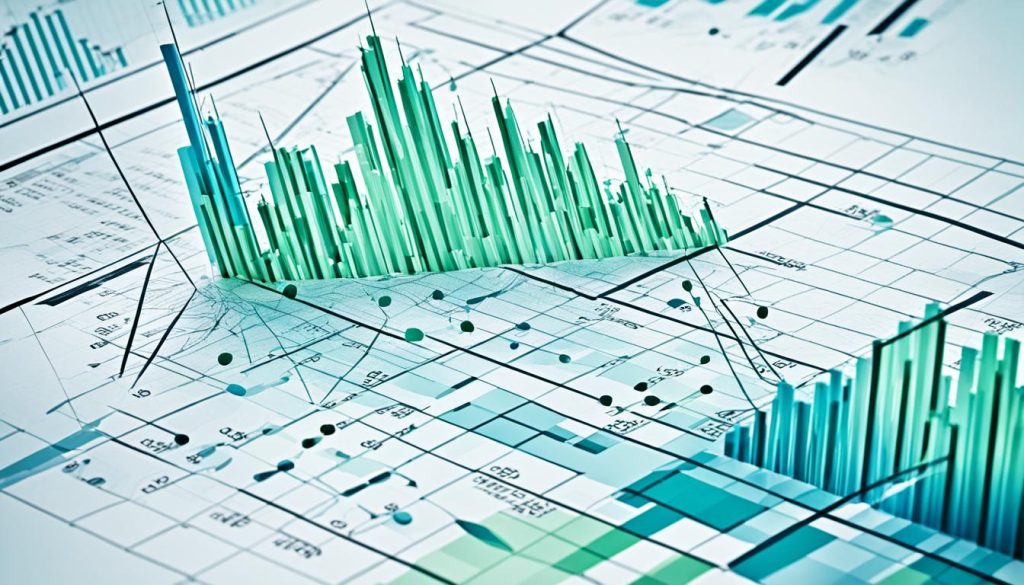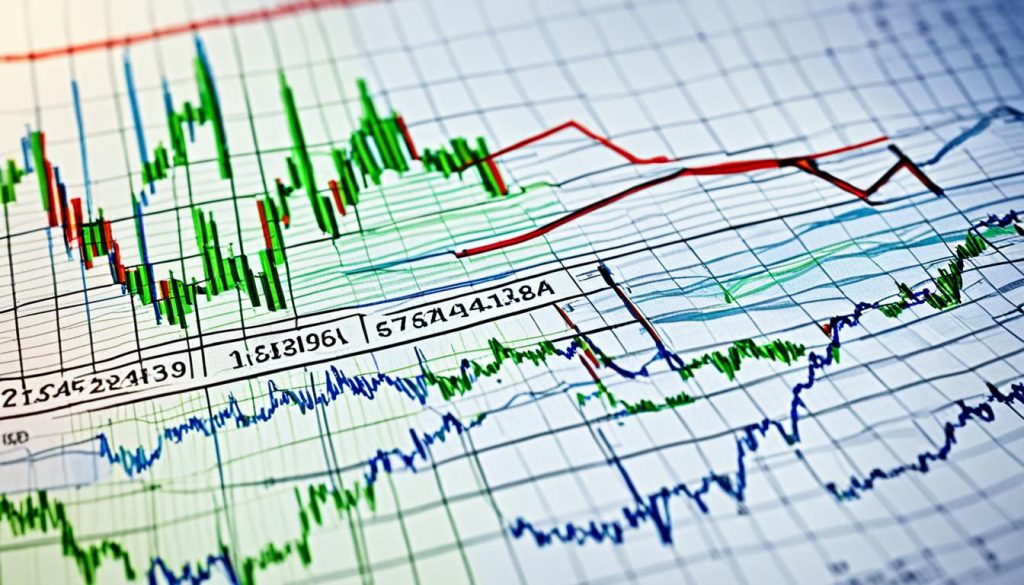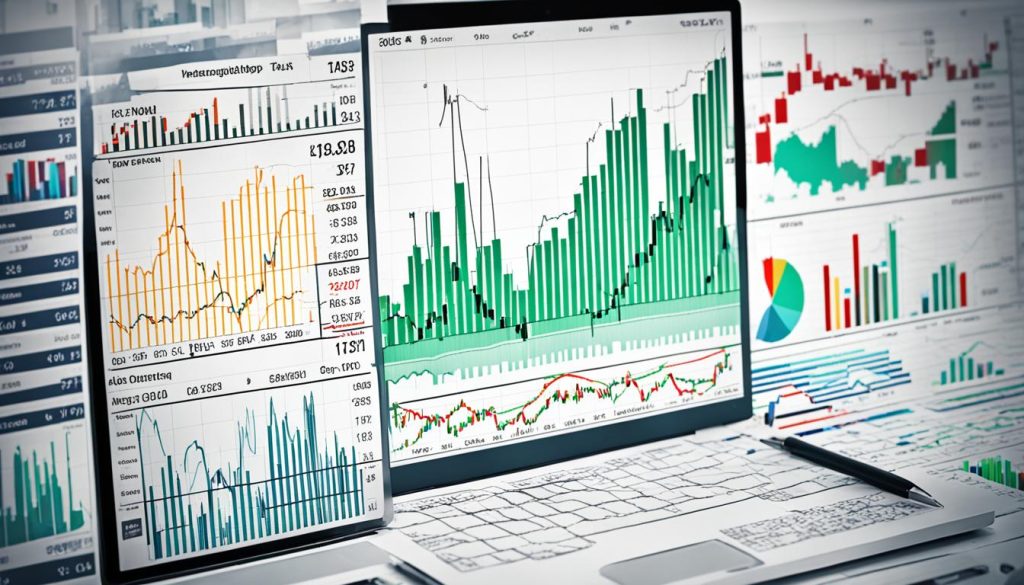In the world of investing, technical analysis is a key tool. It looks at trading trends, not just a company’s financials1. By studying market data, technical analysts aim to spot patterns and forecast price changes. This helps guide your investment choices1.
Technical analysis is used in many markets, like stocks, commodities, and forex1. It gives a fresh view of the market. This lets you spot trading chances based on past data2. It’s useful for all traders, from day traders to long-term investors. Knowing technical analysis can boost your decision-making and might increase your returns3.
Key Takeaways
- Technical analysis looks at market data to find patterns and trends.
- It’s used in markets like stocks, forex, and commodities.
- It’s important to understand the logic behind technical analysis.
- Technical analysis helps find trading chances and manage risk.
- Using it with fundamental analysis makes for a full investment strategy.
What is Technical Analysis?
Technical analysis is a key tool for investors. It looks at statistical trends in trading activity to predict price movements and volume4. Analysts believe past trading and price changes hint at future prices4. They use charts to spot short-term trading signals and check a security’s strength4.
This method works with many securities like stocks, futures, commodities, and currencies4.
Key Takeaways
- Technical analysis helps spot trading and investment chances4.
- It suggests past trading and price changes can predict future prices4.
- It’s different from fundamental analysis, which looks at a company’s finances4.
Technical analysis assumes the market reflects everything, prices follow trends, and history repeats5. It’s most useful in liquid markets5. Volume is key and confirms price movements5.
But, technical analysis has its limits. Critics say it may not work if history doesn’t repeat, or if the market already knows everything4. Experts believe in market trends and history repeating4.
“Technical analysis is a form of security analysis that uses price data and volume data typically displayed graphically in charts.”5
| Characteristic | Technical Analysis | Fundamental Analysis |
|---|---|---|
| Focus | Price and volume data | Financial information and intrinsic value |
| Time Frame | Short-term | Long-term |
| Approach | Identifying patterns and trends | Evaluating a company’s financials |
| Objective | Predict future price movements | Determine a stock’s true value |
In summary, technical analysis is great for those wanting to spot market trends and opportunities465.
Underlying Assumptions of Technical Analysis
Technical analysis tries to understand market feelings by looking at price patterns. It’s based on Charles Dow’s ideas. He believed markets are efficient and that prices show all important info. He also thought random price changes follow patterns that keep happening7.
Now, experts in technical analysis believe three main things. They think the market already knows everything, prices follow trends, and past events will happen again. They see patterns in price moves because of how people feel, like fear and excitement8.
Studies show that small patterns exist in most markets. This means technical analysis alone can’t make you rich8. Yet, technical analysis is still growing. Analysts keep finding new ways to spot important patterns in market data.

Knowing what technical analysis is based on helps investors make better choices. It’s useful for both new and experienced traders. It sheds light on how markets work and why prices change.
technical analysis, stock charts, investment strategies
Different Approaches
Investors often choose between two main methods: top-down and bottom-up analysis. Top-down looks at the big picture, like the economy, before focusing on stocks9. This helps spot big trends that might influence stock choices. Bottom-up, however, digs into each stock’s details, using charts and indicators9.
Which method an investor picks depends on their goals and style. Day traders, for example, might use top-down to catch quick market shifts9. Long-term investors might go for bottom-up to find companies with strong futures9.
Technical analysts use many tools to check stock performance. They look at charts, volume, and indicators like the RSI and MACD109. They also search for patterns, like the Head and Shoulders, to spot trend changes10.
But, the value of technical analysis is still up for debate11. Some say it’s not much better than guessing, while others believe it can be powerful with fundamental analysis11. Success in investing depends on the investor’s skills, how much risk they can take, and the market’s state.

“Technical analysis is the study of market action, primarily through the use of charts, for the purpose of forecasting future price trends.” – John J. Murphy
Technical Analysis Tools
Technical analysis is a key tool for investors and traders. It offers deep insights into market trends and potential trading chances. At its core, technical analysis uses various tools to help you make better decisions12.
Drawing tools like trendlines and support/resistance levels add visual cues to a stock’s chart. They highlight important levels and patterns12. Candlestick patterns, made up of one or more candlesticks, signal market reversals or trends13.
Chart patterns, similar to candlestick patterns, cover larger time frames. They give clues about a stock’s future direction12. Technical indicators, such as moving averages and the relative strength index (RSI), analyze market price and volume data. They offer insights into momentum and trends13.
By learning these technical analysis tools, you can better understand the markets. This helps you make more informed investment choices. These tools are crucial for both seasoned traders and beginners to navigate the financial world.
Successful technical analysis needs patience, practice, and a desire to keep learning. By using these powerful tools and understanding market dynamics, you can find new opportunities. This could help you reach your investment goals.
Conclusion
Technical analysis is a useful tool for investing and trading strategies. It should be paired with fundamental analysis. By understanding technical analysis and its tools, you can spot trading chances and manage risk. It looks at a stock’s past performance, like prices and trading amounts14. Market size is also key when picking stocks for technical analysis14.
But remember, technical analysis isn’t perfect. Traders should be careful and spread out their investments to avoid big losses. Screening can narrow down stocks from many to a few based on price, size, and industry trends14. It’s better for short-term trades than long-term investments14. A mix of technical and fundamental analysis can lead to smarter choices and reaching your financial goals.
Using technical analysis tools like Relative Strength Index (RSI), Moving Average Convergence Divergence (MACD), and Bollinger Bands15 helps spot trading chances and manage risk. Adding technical and fundamental analysis helps in knowing the best times to buy or sell16. A balanced strategy that looks at both technical and fundamental aspects can lead to better investment decisions and reaching your financial goals.
FAQ
What is technical analysis?
Technical analysis looks at trends in trading activity, like price and volume changes. It uses this data to predict future price movements. This is different from fundamental analysis, which looks at a company’s financials to value securities.
What are the key assumptions of technical analysis?
Technical analysis relies on three main ideas. First, the market reflects all available information. Second, price trends repeat themselves. Third, past market patterns can help predict future ones. These ideas come from the idea that market psychology is predictable.
What are the different approaches to technical analysis?
There are two main ways to do technical analysis. The top-down method looks at the big picture before focusing on specific stocks. The bottom-up method focuses directly on individual stocks. The choice depends on the trader’s strategy and time frame.
What are the key tools used in technical analysis?
Tools like drawing tools, candlestick patterns, and technical indicators are key in technical analysis. They help traders spot good trading chances and make better decisions.
How can technical analysis be used in conjunction with other forms of analysis?
Using technical analysis with other methods, like fundamental analysis, can be powerful. It helps investors spot trading chances and manage risks. But, technical analysis isn’t perfect. It’s important to be careful and keep a diverse portfolio.
Source Links
- How to Do Technical Analysis of Stocks: Technical Analysis Trading Tips – VectorVest
- Technical Analysis for Stocks: Beginners Overview
- How Technical Analysis is Used in Both Trading and Investing | TrendSpider Blog
- Technical Analysis: What It Is and How To Use It in Investing
- Technical Analysis
- Technical Analysis of Stocks and Trends Definition
- What is Technical Analysis & How to Use it?
- CHARTISTS AND TECHNICAL ANALYSTS
- Technical Analysis of Stocks: A Beginner’s Guide | SoFi
- Technical Analysis for the Long-Term Investor | The Motley Fool
- Stock Charts: Technical Analysis & Trading Patterns – Wall Street Survivor
- Technical Analysis – A Beginner’s Guide
- What Is Technical Analysis and How Does It Work?
- Technical Analysis Strategies | TrendSpider Learning Center
- The Battle of Strategies: Fundamental Analysis vs Technical Analysis

